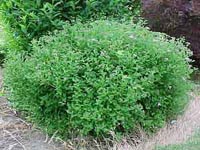Resource Library
Plant of the Week: Anthony Waterer Spirea
The University of Arkansas System Division of Agriculture does not promote, support or recommend plants featured in "Plant of the Week." Please consult your local Extension office for plants suitable for your region.
Plant of the Week
Anthony Waterer Spirea
Latin: Spiraea X bumulda 'Anthony Waterer'

The summer flowering spireas have consistently helped provide beauty for the early
summer display. Not only are these plants summer flowering, they are also small of
stature and fit nicely in the smaller landscapes we use today.
Anthony Waterer Spirea is one of the summer flowering spireas that bloom on new growth
each summer. The flowers are pink to cherry-colored and while individually small,
are borne in a flat head up to four inches across. It is a deciduous member of the
rose family that grows to about 30 inches tall and wide. Leaves are willow-like and,
in this selection, often variegated. Anthony Waterer Spirea is extremely variable
in its variegation pattern. Often times, entire branches will be produced with all
leaves white and completely lacking in chlorophyll. In other leaves the leaf will
be divided down the middle with half variegated and half normal. Most leaves though
are completely normal and show no variegation.
The species from which this selection were introduced from Japan into England about
1865. In the 1880s the variegated form was discovered and named after the nurseryman
at the Knapp Hill Nursery where it was first propagated. This plant, and its more
dwarf cousin, Spiraea japonica, have produced yellow-leafed forms which have become
popular plants in the nursery trade.
Spireas, such as Anthony Waterer make excellent plants for adding to the front of
mixed shrub borders that have a lot of evergreen plants. The twiggy deciduous form
of the plant softens the stark green leaves of the evergreens in winter. In the summer
the pink flowers add an interesting foil to the landscape.
Spireas are best suited to full sun conditions. They are not particular about soil
type but, like most shrubs, grow faster and bloom more profusely in richer soil. Once
established they show excellent drought tolerance. If pruning is needed, cut them
back hard just before new growth begins in the spring.
By: Gerald Klingaman, retired
Extension Horticulturist - Ornamentals
Extension News - June 18, 1999
The University of Arkansas System Division of Agriculture does not maintain lists of retail outlets where these plants can be purchased. Please check your local nursery or other retail outlets to ask about the availability of these plants for your growing area.